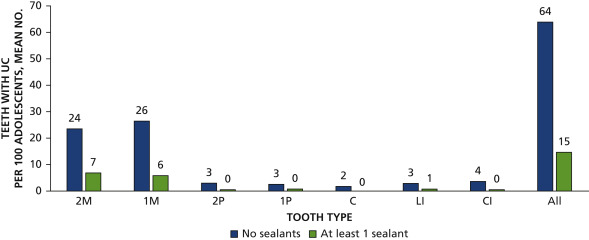Background
Untreated caries (UC), although highly prevalent, is largely preventable. Information
on the contribution of different teeth to UC prevalence and severity could be helpful
in evaluating UC surveillance protocols and the relative benefits of caries prevention
interventions.
Methods
The authors combined data from 3 cycles (2011-2016) of the National Health and Nutrition
Examination Survey for participants aged 6 through 11 years, 12 through 19 years,
20 through 34 years, 35 through 49 years, 50 through 64 years, 65 through 74 years,
and 75 years and older. For each age group the authors calculated the contribution
of successive permanent tooth types (for example, first molars and second molars)
to UC prevalence and severity.
Results
UC prevalence and the percentage of prevalence detected by means of screening molars
were, respectively, 5% and 95% among participants aged 6 through 11 years; 16% and
92% among participants aged 12 through 19 years; 29% and 86% among participants aged
20 through 34 years; 26% and 70% among participants aged 35 through 49 years; 21%
and 48% among participants aged 50 through 64 years; 16% and 36% among participants
aged 65 through 74 years; and 17% and 25% among participants 75 years and older. Among
adults aged 50 years and older, no teeth appeared to capture a disproportionate share
of UC prevalence. Molars accounted for 87%, 79%, and 56% of severity among participants
aged 6 through 11 years, 12 through 19 years, and 20 through 34 years, respectively.
After age 34 years, molars accounted for less than 50% of severity.
Conclusions
Molars are the tooth type most susceptible to UC well into adulthood.
Practical Implications
Molars could be used as sentinel teeth for surveillance of UC and adults could benefit
from caries prevention that targets molars.


